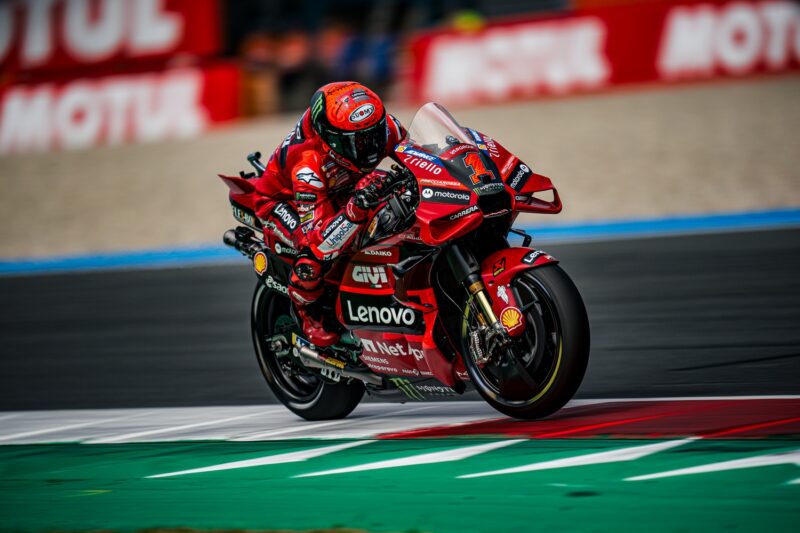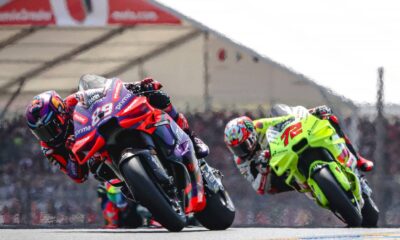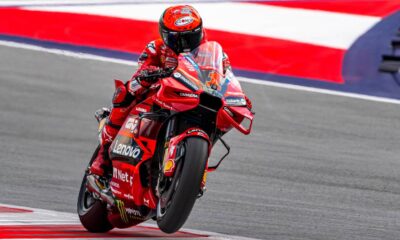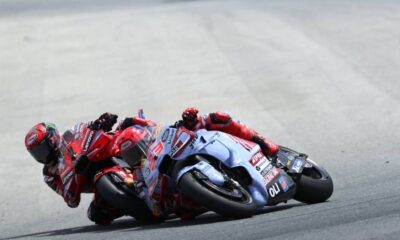Motorsport
A summer look back at the MotoGP season or How Ducati is (not) emulating Red Bull in F1 so far
MotoGP is back! This weekend sees the ninth round of this year’s series take place at the former military airfield at Silverstone as part of the British Grand Prix. And as the road motorcycle world championship circus makes its debut after an extremely long six-week break, it’s not a bad idea to recap the highlights of the previous eight events so far.

MotoGP is back! This weekend sees the ninth round of this year’s series take place at the former military airfield at Silverstone as part of the British Grand Prix. And as the road motorcycle world championship circus makes its debut after an extremely long six-week break, it’s not a bad idea to recap the highlights of the previous eight events so far. We’ll also take a look at the key points and stories that have most influenced this year’s MotoGP. And finally, we’ll take a look at the circuit itself, where the world’s fastest machines will soon be racing.
Eight races down, twelve to go. Even though we are already in August and more than four months have passed since the opening round of MotoGP this year, the riders of the most prestigious category will have a very hectic schedule in the near future. The aforementioned twelve rounds are spread over just seventeen weeks, which may not make all the staff in the World Championship paddock too happy, but will land the fans with an almost never-ending whirlwind of motorsport spectacle.
Entering the “second half” of the MotoGP season as championship leader Francesco “Pecco” Bagnaia. The Italian, riding for the factory Ducati team, holds a 35-point lead over stablemate Jorge Martín of satellite Pramac. Marco Bezzecchi, also a Ducati rider but from MotoGP legend Valentino Rossi’s squad, is just one championship “dot” behind him.
Double the races = double the chance of injury
The world of MotoGP has undergone the biggest change in its nearly three-quarters of a century-long history for the 2023 season. Taking a page from Formula 1, shorter races, or sprints, have arrived. However, following the example of the World Superbike Championship, which traditionally runs more races per weekend, MotoGP has decided to apply sprints to the programme of all the grand prix.
This left the riders with a total of 42 starts (before the recall of the Kazakhstan VC) and approximately 50% more laps in race mode. The very first sprint of the season at the VC of Portugal took a toll on teammate Bagnaiy Enea Bastianini. The Italian picked up a right shoulder injury which sidelined him until the Italian Grand Prix.
Bastianini, however, at least got to experience his MotoGP sprint debut with the others in Portugal. Pól Espargaró of satellite team KTM GasGas crashed heavily during Friday’s practice session. After being kicked up by a machine, the then 31-year-old Spaniard travelled at high speed through the gravel paddock and subsequently flew into the tyre barrier.
Espargaró suffered multiple injuries to his face and chest, from which he was treated until recently. The 2013 Moto2 champion returns to the MotoGP carousel this weekend.
However, these two accidents did not complete the total of injured riders from the season opener. Miguel Oliveira was brought down on the third lap of the main event by eight-time world champion Marc Márquez. Both also picked up injuries from the grand prix that temporarily prevented them from further participation in the series.
This left only 18 men for the second race in Argentina. This number was further reduced by one for Sunday’s race, as Joan Mir crashed in the sprint and also due to physical disability did not take the start grid the next day.
Whatever one’s reasons for being a fan or opponent of changes to grand prix weekends, the sprints only confirmed that motorcycle sport is a highly dangerous business. And with an increasingly balanced starting field, the chances of any sort of blowout are only increasing.
One stable’s dominance in F1? It’s not much better in MotoGP
Although it has now been said that the current level of competitiveness in MotoGP is at a record high, that doesn’t necessarily mean that all factories have a chance of success. If Red Bull is an unbeatable entity in Formula 1, then the Ducati stable is mimicking similar success in MotoGP.
The Italian factory has eight machines in the starting field, which normally represents around a third of the total number of machines in the premier class. Unlike other factories with more than two bikes, Ducati supplies all its teams with very competitive machines. It’s no surprise, then, that of the sixteen races Ducati has ridden so far, Ducati has dominated thirteen of them.
Reigning world champion Bagnaia has absolutely conquered his first grand prix with wins in both the sprint and the main race. While the second race of the season in Argentina saw Brad Binder and KTM triumph on Saturday, Bezzecchi claimed the win 24 hours later after Bagnaia crashed out of second place. In the U.S. Grand Prix, Álex Rins shocked on a satellite Honda by finishing second to Bagnaia on Saturday. He even took the win himself the following day, but mainly due to another mistake by Bagnaia, this time from the lead.
Binder’s sprint triumph at the Spanish VC ends the list of non-Ducati factory successes. The Bologna-based stable subsequently went unbeaten until the main race in Assen, the Netherlands, at the end of June. All the gold medals were given to Bagnaio, Bezzecchi or Martín during this interval.
It is clear that Ducati’s dominance is not much to compare with that of Red Bull. In MotoGP, at least the Ducati riders are battling it out amongst themselves, and the aforementioned trio of riders will almost certainly fight it out for the world title. The current state of the championship, however, does not feed into the debate over who will win from outside Ducati, but rather how many riders from the Italian stable will be on the top step by the end of the season.
What happened to the Japanese brands?
Gone are the days when Japanese machines ruled MotoGP. Unless a rider was riding a Honda, a Yamaha or a Suzuki, he had no chance of challenging for a win, let alone a world title.
After Marc Márquez’s crash at Jerez three years ago, the hegemony of the Japanese stables was in arguably the biggest crisis in the history of the brands’ participation in MotoGP. Although Joan Mir (Suzuki, 2020) and Fabio Quartararo (Yamaha, 2021) brought their teams the rider titles, almost all the constructor and team scalps were taken by Ducati. Last year, Bagnaia finally secured a world championship for the stable after 15 years. And it looks like Ducati will take all the championship crowns this year as well.
The Japanese footprint in the series, on the other hand, is slipping further and further in numbers and results. Suzuki left MotoGP last year, Yamaha lost its satellite team and Honda’s machines are mowing down one of its riders after another. The experienced Márquez even suffered five crashes during the German VC only to mercilessly match his increasingly fast rivals.
Yamaha and Honda can look forward to a US podium for Quartara and Rins respectively. However, both stables are hopelessly languishing at the bottom of the constructors’ standings. This is frustrating MotoGP officials, who are even considering changing the rules on technical concessions to give these marques a chance to get back on the winning streak.
Clearly, Honda and Yamaha are developmentally no match for their European rivals. The increasingly prominent role of aerodynamics in MotoGP is something the Japanese have slept on and are currently not very good at. And with new technical regulations not coming into force until the 2027 season, the question is whether they will lose patience with MotoGP by then. Similar concerns were admitted by former Ducati, Honda and Suzuki boss Livio Suppo in March.
What’s in store for us at Silverstone this weekend?
The six-week break has allowed riders, engineers and staff to take a break from all the noise surrounding MotoGP. This weekend sees them back at work and Ducati looks set to continue its compelling form. KTM and Aprilia will be looking to hold them to what they can. And Honda and Yamaha will be looking for new leads to potentially climb up the ranks.
The characteristics of the Silverstone circuit, with its tight corners and fast passages, should best suit the Ducati favourites. With the stable having completely dominated the Sachsenring race in Germany, which on paper shouldn’t favour them too much, it’s not too much to suggest that their package should struggle at Silverstone.
Silverstone has hosted the MotoGP British Grand Prix since 2010, when it replaced Donington Park. With the exception of 2011 and 2012, the start and finish line for the World Championship races lay on the straight between Woodcote and Copse corners. For this year, the start and finish area reverts back to Hamilton Straight, where Formula 1 cars traditionally set off from.
MotoGP riders will have 10 laps on Saturday and 20 laps on Sunday around this famous 5.9km circuit. Bagnaia will be looking to repeat his triumph from last year. Can he replicate his success at Assen, where he won repeatedly at 12-month intervals during the last grand prix? Or will he once again make the mistake he has already made three times this year and allow his nearest rivals to catch up in points?
Sources: GPone.com, MotoGP

-
Motorsport5 days ago
Jorge Martín is rewriting history! the 26-year-old Spaniard became the new MotoGP World Champion, Bagnaia succumbed despite his best efforts
-
Motorsport6 days ago
Bagnaia keeps hopes of a miracle alive with MotoGP sprint win in Barcelona, third-placed Martín one step away from title





